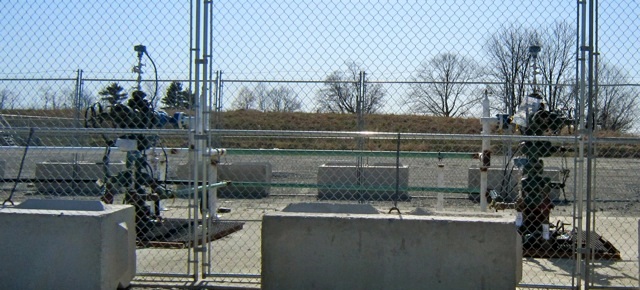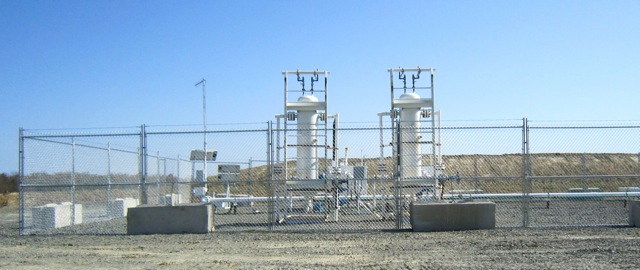Researchers using a sensitive chemical analysis say they have found evidence of fracking fluids in well water near a shale gas drilling site in Pennsylvania. It’s one of the first scientifically documented cases of fracking fluids seeping into drinking water.
Groundwater contamination has been a contentious issue surrounding fracking, or hydraulic fracturing. And now researchers have offered comprehensive scientific evidence of contamination rising up through well water. “Although media reports of incidents are common, published reports are few,” the authors of the new study say.
A History of Contamination

In southeast Bradford County, Pennsylvania, a handful of families live along the northern branch of a stream called Sugar Run. At least three of these households get their drinking water from wells.
A gas company built five well pads, dubbed Welles 1 through Welles 5, about a mile north of the branch in 2009 and 2010. The company drilled two wells at each pad. During construction, the Pennsylvania Department of Environmental Protection (PADEP) reported a drilling fluid leak from a pit at Welles 1, but construction finished without any other mishaps by September 2009. Hydraulic fracturing started at Welles 1 and finished by February 2010.
Meanwhile, the company was drilling at Welles 2 to 5, which finished in May 2010 — but at Welles 3 and Welles 4, pressure in the space between the casing and the well bore, called annular pressure, was higher than the maximum limit.
In shale gas drilling, the well is usually cased in steel pipe and cement to keep gas or fracturing fluids from leaking into the surrounding rock and soil. When the company drilled the first two wells, at the Welles 1 pad, they only installed a casing down to 300 meters below the ground, and then between 2100 and 2300 meters. The well had no casing from 300 meters to 2100 meters, which the report calls “intermediate depths.”
In July 2010, 3 of the houses along Sugar Run found natural gas and sediment in their well water, which had also started foaming white. Around the same time, natural gas vapour in the basement of one house forced a temporary evacuation.
The company installed replacement water wells for the affected houses. Not long afterward, natural gas turned up in the new wells. Late in the summer of 2010, the gas company installed water treatment systems in the houses.
Although PADEP and private consultants had started analysing water samples from the wells right away, it took until May 2011 for PADEP to cite the company. According to the state, the gas company had violated state law by allowing natural gas to enter the water supply. The company refused to admit fault, but it did take action to reduce the annular pressures at Welles 3 and Welles 4.
A year later, the homeowners won a civil suit against the company. In order to trace the contamination back to the gas company, consultants had matched the isotopic signatures of natural gas from the gas wells to the natural gas found in the homes’ drinking water. The presence of high annular pressures in the gas well, combined with how soon after drilling the contamination appeared, also helped make the case. The contamination nightmare seemed to be over.
Then, with state approval, the company began hydraulic fracturing at Welles 2 to 5 in November 2012.
Environmental CSI
Enter the scientific team. Garth T. Llewellyn, Frank Dorman, and their colleagues investigated an aquifer in Bradford County, Pennsylvania, where state investigators had found methane contamination in the water back in 2011. During PADEP’s investigation, and during the civil suit, analysis of well water from the homes had only found methane in the water. No traces of fracturing fluids had appeared in the well water.
So the researchers teamed up with private-sector environmental consultants to test a new way of looking for contaminants in groundwater. The method combines gas chromatography, which separates the different components of a mixture, with mass spectrometry, which identifies chemicals present in a substance. The researchers say their technique hasn’t been used in contamination cases before, primarily because most of the labs that provide analysis in these cases don’t have the capability.
But they claim it’s much more sensitive than current testing methods, which means it can detect smaller amounts of contamination.
For the new study, researchers took samples of water from the affected households’ wells, along with samples from uncontaminated water wells nearby to use as a control. Using their new technique, they compared those water samples to flowback water (water and fracturing fluids that flow back to the surface after fracturing) and a drilling additive called Airfoam HD.
The company that makes Airfoam HD says, “Airfoam HD is an all-purpose, air-drilling surfactant that foams in fresh water, brine and the presence of oil.”
Llewellyn and his colleagues found hydrocarbons in the flowback water and the contaminated groundwater, but that’s not surprising — methane is a hydrocarbon, and it’s usually associated with other hydrocarbons. More significantly, the researchers found a chemical compound called 2-n-Butoxyethanol in Airfoam HD, the flowback water, and the contaminated groundwater. It was well below the limits set by state regulations, but the finding offers compelling evidence that fracking fluids made their way into the groundwater along Sugar Run.
The researchers say that the high pressure in the shale gas wells at Welles 3 and Welles 4 were probably partly to blame for the contamination.
Read the full scientific report in Proceedings of the National Academy of Sciences.
Pictures: Ostroff Law, via Wikimedia Commons
